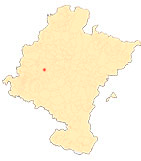La Portada de San Miguel de Estella
General composition
The figures are arranged in an orderly fashion. The beautiful tympanum is dedicated to the majesty of God. The five archivolts group together more than a hundred figures in a rigorous hierarchy of greater to lesser dignity on the spiritual scale of being, from the holiest, the turiferary angels who form part of the heavenly glory, to the elders of the Apocalypse, the prophets and scenes from the public life of Christ, to conclude, on the external thread, with scenes from the lives of the saints. On a more distant level, the chambrana is filled with fanciful figures, animals and personifications. Eight of the ten capitals make up a rich cycle of the infancy of Christ, accompanied by two wrestling capitals. The most unique feature are the two enormous reliefs whose figures descend almost to the height of the spectators, before whose eyes take shape the visitof the three Marys at the tomb of Christ and St. Michael in his double role as conqueror of the devil and conductor of souls to paradise. Above the reliefs, two small arches shelter an apostolate that completes the programme. Seen from the inside out, the façade shows us the splendour of heavenly glory and its irradiation towards the earthly world; seen from the outside in, sampleshows the Christian faithful the path to salvation.
The tympanum and its thematic links with the archivolts have clear precedents in French portals related to the western one at Chartres, although the presence of Mary and Saint John at the ends places this work from Estella on contactwith other Spanish ones such as San Nicolás de Tudela, Santo Domingo de Soria or Moradillo de Sedano, from which it differs in other aspects (for example, the one from Soria and the one from Burgos have radial figures in the archivolts). Although its execution is close in time to the equally impressive Santa María de Sangüesa, the stylistic and compositional differences are obvious.
The work from Estella shows care in the planning, although there is no lack of details that are not compatible with rigorous forethought, such as the off-centre position of several keystones. Also surprising is the different format of the apostolate (eight large standing figures next to four much smaller seated ones). Although these inconsistencies have been justified by the hypothesis of two phases (one of carving and the other of assembly, separated by an indeterminate period of time), this possibility does not satisfy all the questions raised by the composition of the door.











